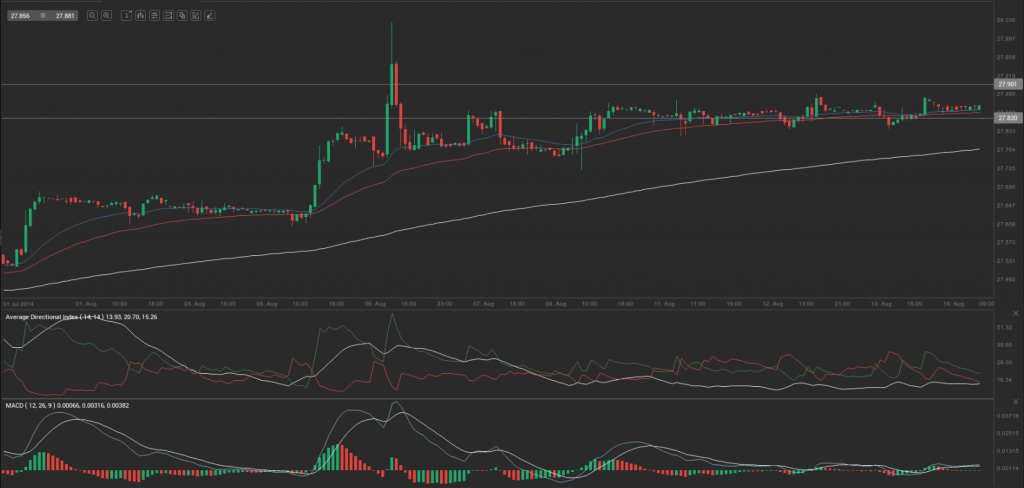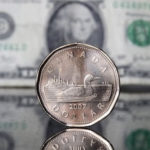Yesterday’s trade saw EUR/CZK within the range of 27.8211-27.8922. The pair closed at 27.8708, gaining 0.03% on a daily basis.
At 8:07 GMT today EUR/CZK was down 0.01% for the day to trade at 27.8691. The pair touched a daily low at 27.8664 during early Asian session.
Fundamental view
Euro zone
At 8:00 GMT the European Central Bank will release its Monthly Report, including detailed analysis of current and future economic conditions and price stability risks in the Euro region from bank’s perspective. It is usually published one week after ECB’s interest rate decision.
The annualized final consumer price index in the Euro zone, evaluated in accordance with Eurostat’s harmonized methodology, probably confirmed the preliminary HICP of 0.4% in July, according to the median estimate by experts. The index shows the change in price levels of a basket of goods and services from consumer’s perspective and also reflects purchasing trends. The main components of the HICP are food, alcohol and tobacco (accounting for 19% of the total weight), energy (11%), non-energy industrial goods (29%) and services (41%). The HICP is used to evaluate and compare inflation rates between Member States, according to Art. 121 of the Amsterdam’s Agreement and directives by the European Central Bank (ECB), in order the latter to achieve price stability and the implementation of monetary policy. The HICP aggregates are calculated as the weighted average of each member state’s HICP components. The weight of each member state is presented by its share of household final monetary consumption expenditure in the total of the country’s group.
The HICP registered a record low level of -0.70% in July 2009.
In case the HICP slowed down more than anticipated, thus, distancing from the 2% inflation objective set by the ECB, this would mount selling pressure on the euro, because of the greater possibility of introducing additional monetary policy measures in order to stimulate economy.
The annualized final Core HICP for July probably matched the preliminary Core HICP, reported at 0.8% on July 31st. This index excludes volatile categories such as food, energy, alcohol and tobacco. Eurostat is scheduled to release the official inflation data at 9:00 GMT.
The seasonally adjusted preliminary Gross Domestic Product in the Euro zone probably expanded 0.1% during the second quarter compared to Q1, according to expectations, following a 0.2% increase of the GDP in the first quarter, according to final data. The preliminary GDP during the second quarter of the year compared to Q2 2013 probably showed a 0.7% expansion, after a 0.9% increase in Q1. The GDP represents the total monetary value of all goods and services produced by one nation over a specific period of time. What is more, it is the widest indicator of economic activity in the region. The report on GDP holds a lot of weight for traders, operating in the Foreign Exchange Market, because it serves as evidence of growth in a productive economy, or as evidence of contraction in an unproductive one. As a result, currency traders will look for higher rates of growth as a sign that interest rates will follow the same direction. Higher interest rates will usually attract more investors, willing to purchase assets in the Euro area, while, at the same time, this will increase demand for the common currency. Therefore, in case growth in the single currency zone exceeded expectations, this would provide support to the euro. Eurostat is expected to release the preliminary GDP report at 9:00 GMT.
Czech Republic
Preliminary Gross Domestic Product of the Czech Republic probably rose 2.9% in the second quarter of the year, compared to the same period a year ago, according to the median forecast by experts. Nations economy grew at a pace of 2.9% during Q1, according to final data. Accelerated growth usually provides support to the local currency.
The annualized GDP of the country registered expansion at the record-high rate of 7.6% during Q1 2006.
On a quarterly basis, Czech Republics economy probably grew 0.2% in Q2, following a 0.8% GDP growth in Q1. The Czech Statistical Office is to release the preliminary GDP figure at 7:00 GMT.
Technical view
According to Binary Tribune’s daily analysis, the central pivot point for the pair is at 27.8614. In case EUR/CZK manages to breach the first resistance level at 27.9016, it will probably continue up to test 27.9325. In case the second key resistance is broken, the pair will probably attempt to advance to 27.9727.
If EUR/CZK manages to breach the first key support at 27.8305, it will probably continue to slide and test 27.7903. With this second key support broken, the movement to the downside will probably continue to 27.7594.
The mid-Pivot levels for today are as follows: M1 – 27.7749, M2 – 27.8104, M3 – 27.8460, M4 – 27.8815, M5 – 27.9171, M6 – 27.9526.
In weekly terms, the central pivot point is at 27.8419. The three key resistance levels are as follows: R1 – 28.0652, R2 – 28.2652, R3 – 28.4885. The three key support levels are: S1 – 27.6419, S2 – 27.4186, S3 – 27.2186.






